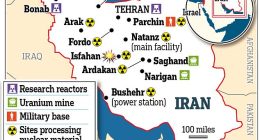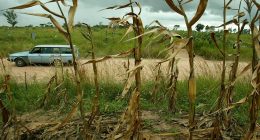
It was one of the largest manhunts in history. Having been ousted from power following the 2003 U.S. invasion of Iraq, Saddam Hussein, the country’s once all-powerful and ruthless leader, went into hiding as an estimated 150,000 troops scoured the land for the individual known as “High-Value Target Number One.”
Incredibly, Hussein evaded capture for almost eight months, famously emerging disheveled and bearded from a tiny purpose-built hole under a flowerbed near the town of Tikrit. Three years later, he was hanged.
But who dug the hole for Hussein? Who helped keep him hidden from the U.S. army despite a $25 million reward? In Halkawt Mustafa’s feature doc Hiding Saddam Hussein, the Kurdish/Norwegian filmmaker lets Alaa Namiq tell his incredible story on camera for the first time, explaining how the toppled dictator turned up at his farm unannounced and then spent an incredible 235 days there before he was found. During that time, this humble Iraqi effectively assumed the role of presidential hairdresser, physician and bodyguard.
Speaking to The Hollywood Reporter ahead of Hiding Saddam Hussein’s Middle East premiere at the Red Sea Film Festival on Friday, Dec. 1, Mustafa discussed how he managed to keep his project shrouded in secrecy for almost all its 14-year journey, Tinder’s crucial role in its making, the dramatic adaptation he’s now developing with the writer of The King’s Speech, and the difficulties of bringing a human side to a ruthless dictator responsible for his own family’s fleeing from the region.
When did you first have the idea of finding the man who had kept Saddam Hussein hidden?
As soon as they found Saddam Hussein in the hole I was really curious. Firstly, was it true, because a lot of people didn’t believe it. And then, how was it possible? He was the all-powerful president, so how did he end up in this hole? But I didn’t know how to find the man who helped him. I searched for two years, and then the Washington Post named him in 2012. And with his name, I was given the opportunity to track him down. It took me one year to sit down with him, but then he didn’t want to talk. He’d just come out of Abu Ghraib prison. He was in one of the famous photos taken [with U.S. soldier Lynndie England]. The only reason he’s alive today is because the Abu Ghraib scandal came out and they closed it.
But Alaa Namiq had no connection to Saddam himself?
No, from the beginning I just expected he would have been connected or related. But no, he had no connection. He was just a simple farmer and he was by chance the one chosen to hide Saddam from his family, friends and 150,000 soldiers.
Did you always know it was just one guy?
No, and this has been part of the process of making this movie. The most important thing I learned is how patient you need to be to tell your story. And it’s not only telling his story, but humanizing him and seeing the story from his perspective. We’ve always seen Saddam Hussein as the dictator, the powerful president. But then you see the king losing his power, and then it’s about balance and then Alaa takes over.
As a Kurd whose family was forced to flee due to the brutality of Saddam Hussein, how did it feel for you to explore this human side of him?
To be honest with you, it was hell difficult to make this movie. From my perspective, my mother came from the area which was bombarded by Saddam’s chemical weapons. But I really wanted to give Alaa the chance to tell the story from the Arabic perspective, because almost everything we have seen about the Iraqi invasion has been told from the Western perspective. This is why I decided, almost from the beginning, to let him tell the story in exactly the way he wanted.
After you tracked Alaa down, how did you convince him to speak to you?
I think the one thing that I did that the Washington Post didn’t was that I was patient. I spent 14 years on this from beginning to end. But the turning point was ISIS, because when ISIS took over, Alaa told me that everything Saddam had told him about what would happen to Iraq happened. And then he realized that he had to tell this story. Everything Saddam predicted about the future of Iraq came true.
It must have been fascinating from your side, irrespective of the documentary, to hear about how and why this Iraqi farmer agreed to hide the world’s most wanted man.
I had so many questions. Why didn’t he sell Saddam to claim $25 million. Why couldn’t he just say, sorry I can’t help you because there are 150,000 U.S. soldiers looking for you? Why are you hiding him, not just from U.S. soldiers but even from his family? No one knew. It was really difficult to understand, from my own Scandinavian perspective, why you can’t just escape with your family and leave him, if you’re so scared. But from his perspective, somehow I began to understand, especially if you have only one TV channel in your country and everything about your president is beautiful and perfect, and then he comes to your house and asks you to help. In Arabic culture, you never ask your guests how long they plan to stay. Because Saddam asked if he could stay for one night. In the end, it was 235.
Given the rise of ISIS, was safety a concern when making this?
Yeah, ISIS had taken over where we wanted to shoot the movie. In the end, I secretly brought Alaa to Norway, because no place in the Middle East was safe to do the interview. Also, I want to tell you something funny, but all our communication before that had been through Tinder. Not directly but via middlemen, because it was safe. We made Tinder profiles for the men connecting me with Alaa. Also, almost everything about this project has been kept secret only up until the last two months.
How do you keep a film you’re working on secret for 14 years?
It was something I had to learn! Even in the post-production process, the people who were working on it didn’t know what the project was about. And in Iraq, when we were shooting, I wrote a script about drinking water disappearing from the area. They thought I was shooting a movie about climate change.
I’m assuming this was mostly for Alaa’s safety?
Yeah. We had lots of meetings about ensuring Alaa was kept safe. But he said that the only thing he wanted to happen before he died was to tell people the story, to tell the truth behind the hole.
Obviously, there’s a very serious nature to this story, but it also feels like the relationship between Saddam and Alaa could have several comedic drama elements, particularly over the switch in power as the simple farmer effectively becomes the president’s only protector.
Yeah, this is actually a story of friendship. And this is why I’m working on a drama based on the story with David Seidler, who wrote The King’s Speech. We already have a script, and I hope I’m going to direct.
Read More: World News | Entertainment News | Celeb News
Hollywood





